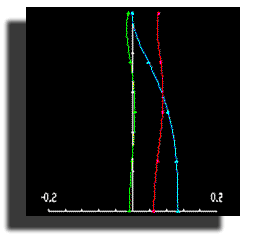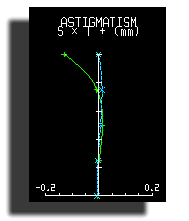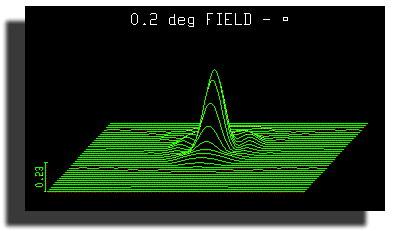 Optical
Performance
Optical
Performance
 Optical
Performance
Optical
Performance
Axial Color and Spherochromatism
When sub-aperture refractive elements are used late in a system, the resulting color error is typically a fraction of what it would be with the same glasses used as an objective. This is what allows designs such as the Brixner and Jones-Bird to approach apochromatic correction in moderate apertures.
When these designs are scaled to 30 inches, however, the color blur becomes several times the diameter of the airy disk. Things quickly get even worse as the primary f/x decreases and the amplification factor of the corrector element is increased. So it immediately became clear that a triplet corrector would be called for in the new design.
 While the choice of glasses for use in a triplet is by now fairly well
established, things change when the lens is required to correct not only its own
aberrations but also those of a fast, heavily aberrated primary. In particular,
the much stronger internal curves which are used to control secondary spherical
aberration can make spherochromatism so bad that the choice of a triplet over a
doublet becomes pointless. Finding different glasses was the solution to
regaining control over both of the above aberrations. (BTW, while I personally
prefer OSLO for its combination of power and easy intuitive use, Don Dilworth's
Synopsys has a wonderful interactive
glass chart which I found invaluable in selecting from among the hundreds of
available glasses.)
While the choice of glasses for use in a triplet is by now fairly well
established, things change when the lens is required to correct not only its own
aberrations but also those of a fast, heavily aberrated primary. In particular,
the much stronger internal curves which are used to control secondary spherical
aberration can make spherochromatism so bad that the choice of a triplet over a
doublet becomes pointless. Finding different glasses was the solution to
regaining control over both of the above aberrations. (BTW, while I personally
prefer OSLO for its combination of power and easy intuitive use, Don Dilworth's
Synopsys has a wonderful interactive
glass chart which I found invaluable in selecting from among the hundreds of
available glasses.)
The glass-types finally chosen for the triplet are Ohara's S-FPL51, BPH8 and PBH1. Of the three, only the first is relatively expensive, though all are "preferred" glasses. With these, both red and blue are brought within the boundaries of the airy disk.
Coma and Astigmatism
 All of the previous designs of this type suffer from considerable
astigmatism. Fortunately, this is negative astigmatism, so that partial
compensation is possible with many eyepieces. The modern Panoptic and Nagler
designs, however, are so well corrected that intentionally leaving astigmatism
in the instrument's design is no longer desirable. This led to the addition of a
small, weak negative meniscus lens positioned just a few inches inside focus.
Such a lens is able to control or eliminate astigmatism, while having relatively
little effect on other aberrations.
All of the previous designs of this type suffer from considerable
astigmatism. Fortunately, this is negative astigmatism, so that partial
compensation is possible with many eyepieces. The modern Panoptic and Nagler
designs, however, are so well corrected that intentionally leaving astigmatism
in the instrument's design is no longer desirable. This led to the addition of a
small, weak negative meniscus lens positioned just a few inches inside focus.
Such a lens is able to control or eliminate astigmatism, while having relatively
little effect on other aberrations.
The Jones-Bird differs from the Brixner mainly in the use of an airspace between the corrector lenses in order to control coma. But it was found to be much more practical in the design of the ICARUS 750 to follow the lead of astigmatic correction and leave coma control for late in the optical train as well. In addition, the presence of 2 lenses here rather than just the single ast-correcting lens gave me a fairly easy way to control lateral color in this design.
 The ray-intercept curve displays first-order coma, such as
that from a Newtonian's primary, as a symmetrical up-turned parabolic curve.
With first-order coma corrected by a field lens, the designer is usually left
with an interesting asymmetrical curve representing secondary coma. While far
smaller in amplitude, this curve generally has an abrupt "tail" at one end. But
the happy fact that it's only on one end makes it possible to design a field
stop which will intercept these aberrant rays. The only question left is one of
compromise between how much of the tail to chop off and how much off-axis
vignetting to allow.
The ray-intercept curve displays first-order coma, such as
that from a Newtonian's primary, as a symmetrical up-turned parabolic curve.
With first-order coma corrected by a field lens, the designer is usually left
with an interesting asymmetrical curve representing secondary coma. While far
smaller in amplitude, this curve generally has an abrupt "tail" at one end. But
the happy fact that it's only on one end makes it possible to design a field
stop which will intercept these aberrant rays. The only question left is one of
compromise between how much of the tail to chop off and how much off-axis
vignetting to allow.
In this design, I've chosen to follow the expamples of those Dob-builders who favor the smallest possible diagonal size -- a similar tradeoff. Here the observational evidence seems to indicate that a 0.3 to 0.5 magnitude drop at the edge of the field is in fact difficult to detect visually.
In the design of the ICARUS 750, there is a loss of about 0.4 mv at the edge of the 35mm Panoptic's field. But by placing the field-stop at the doublet, intead of at the diagonal as is the usual case with Newtonians, the edge of the field brightens quickly as the magnification is increased -- to just 0.25 mv loss with the 27mm Panoptic, for instance.
In any case, the use of an iris diaphragm here would allow the observer to adjust for personal preference.
Full-Field Correction
As shown in the spot diagram, the green blur at 0.2 degrees off-axis (near the edge of the 35mm Panoptic's FOV) is well under the desired 2 arcmin. But the red blur, although less critical due to the eye's much lower sensitivity to this wavelength, is approaching what would appear visually to be a 3 arcmin blur.
 When we're so near the diffraction limit, however, spot
diagrams are somewhat pessimistic. Taking a look at the polychromatic Point
Spread Function, which takes into account the red and blue wavelengths (I've
weighted blue at 0.2 and red at 0.1), there remains a nicely defined central
peak, surrounded by a fairly bright first diffraction ring. Even the outer
diameter of this ring is less than the eye's resolving power of 2 arcmin. And
for fainter stars, where the first ring falls below threshold visibility and we
measure the disk at half-intensity, the image will appear to be only about an
arcminute in the 35mm Panoptic -- less than 0.4 arcsec actual image size.
When we're so near the diffraction limit, however, spot
diagrams are somewhat pessimistic. Taking a look at the polychromatic Point
Spread Function, which takes into account the red and blue wavelengths (I've
weighted blue at 0.2 and red at 0.1), there remains a nicely defined central
peak, surrounded by a fairly bright first diffraction ring. Even the outer
diameter of this ring is less than the eye's resolving power of 2 arcmin. And
for fainter stars, where the first ring falls below threshold visibility and we
measure the disk at half-intensity, the image will appear to be only about an
arcminute in the 35mm Panoptic -- less than 0.4 arcsec actual image size.